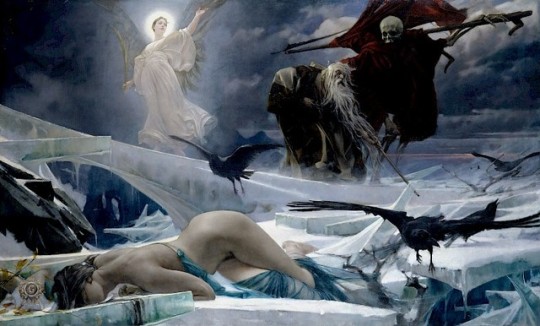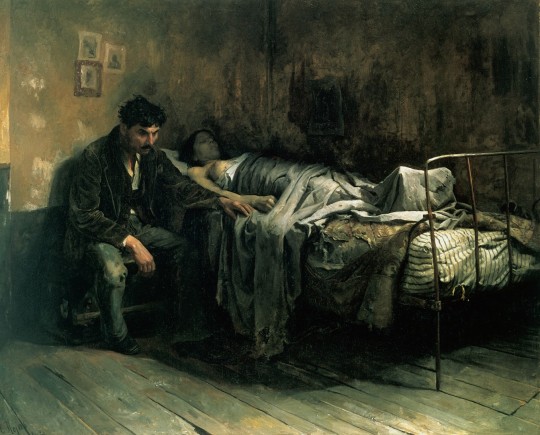#ahasuerus at the end of the world by adolf hiremy-hirschl
Photo

adolf-hiremy-hirschl-ahasuerus-at-the-end-of-the-world-1888
183 notes
·
View notes
Photo

Adolf Hiremy Hirschl - Ahasuerus At The End Of The World ( 1888 )
6 notes
·
View notes
Text
Artist Research: Paintings
Musée du Louvre Memento Mori is a symbolic motif and philosophical approach to accepting and understanding mortality, a useful device that encapsulates historical relationships with death and allows us to analyse perspectives on mortality through time, the term in Latin translates to the phrase ‘remember that you must die’. This expression manifested into visual arts and literature in the 15th century onwards, acting as a reminder of the inevitability of death.
Symbolism is a huge aspect of this movement, creating intense morbid emotions that stay with the viewer. Paintings involving skeletal structures, skulls, reapers, or decay are the most obvious examples of this. But these memento mori paintings were not always as obvious. Vanitas paintings came into popularity in the 17th century, characterised by still life with macabre themes and symbolism weaved throughout – these paintings intended to convey that earthly pleasures are not permanent, that wealth and power were insignificant. Allusions to inescapable transformations were conveyed through subtle imagery, bubbles arguably being the most prominent, as well as wilting flowers, and melting candles. This imagery was used to emphasise that everything is in a constant shift and beauty does not last forever.
The purpose of these artworks was to highlight the transient nature of humanity and life and allow for us to reflect on the present moment. It prompted viewers to examine their relationship with mortality. Memento mori to many, represented an urge to live respectfully and not take life for granted, to celebrate living, but to others it could be interpreted differently.
Memento mori demonstrates how humanity has formed a relationship with mortality, through art. It shows that humans have long had a deep rooted sense of fascination and fear paired with macabre themes and the unknown, and a deep desire to understand the complex experience of death. It could be argued that memento mori has extended from a movement in art history into a broader societal sensation, a transformative experience expressed through a wide spread of media – arts, film, literacy, and ethics.

Böcklin, A. (1872) Self-Portrait with Death Playing the Fiddle. [Oil on canvas]. Alte Nationalgalerie, Staatliche Museen zu Berlin.

Adolf Hiremy Hirschl, (1888) Ahasuerus at the end of the world.

Pieter Claesz (1630) Vanitas Still Life. Mauritshuis Den Haag, Netherlands

De Gheyn II, J. (1603) Vanitas Still Life [Oil on wood]. Metropolitan Museum of Art, New York, NY

Marianne Stokes (1908) Death and the Maiden [oil on canvas] Musee D’Orsay, Paris.

Cristóbal Rojas Poleo (1886) The Misery [oil on canvas] Poleo National Art Gallery, Caracas, Venezuela.

Girodet-Trioson, A. (1808) ‘The Funeral of Atala’ [oil on canvas] Musée du Louvre
0 notes
Photo

Adolf Hiremy-Hirschl - Ahasuerus at the End of the World (1888)
0 notes
Link
0 notes